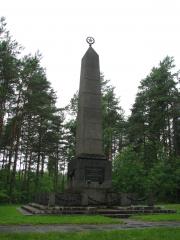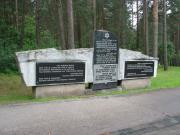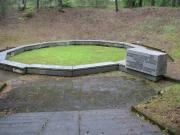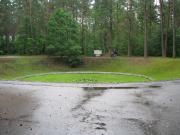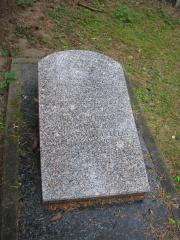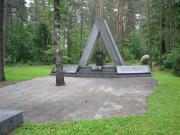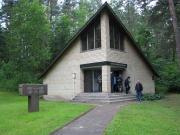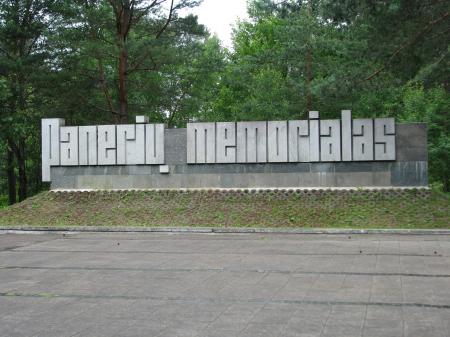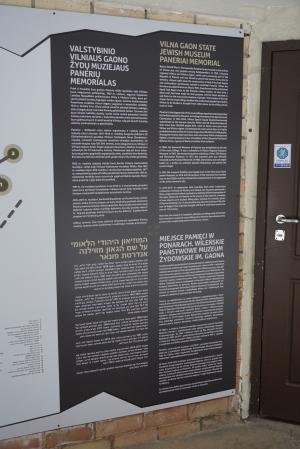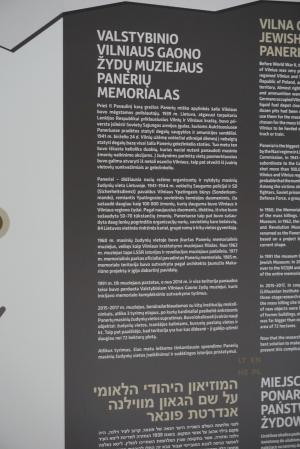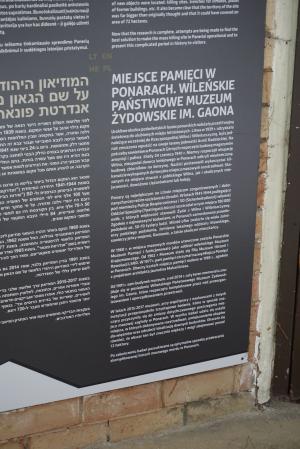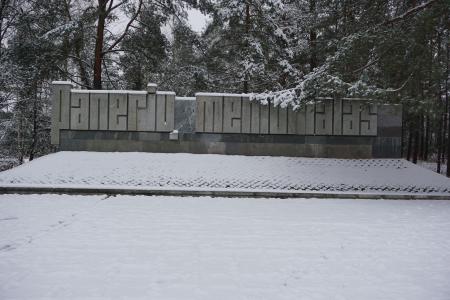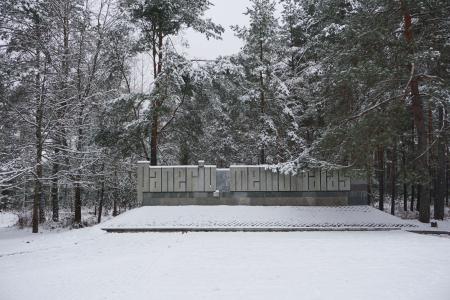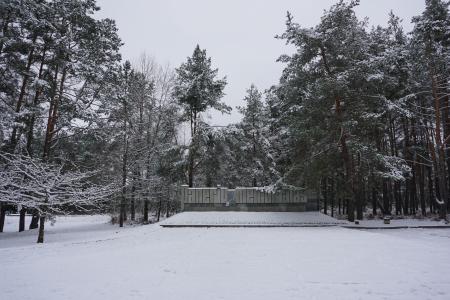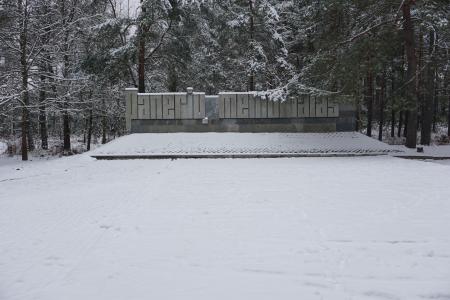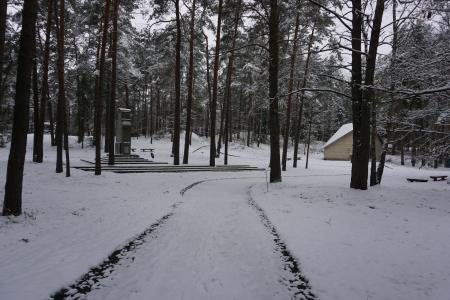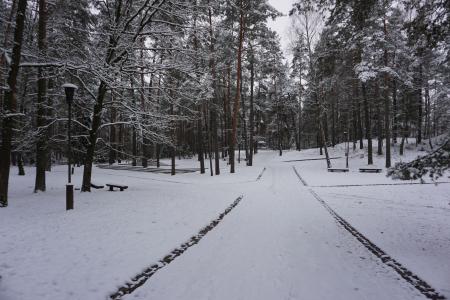Obj. ID: 46045
Modern Jewish Art Paneriai Memorial in Vilnius, Lithuania, from 1948 to 2015

Memorial name
Paneriai Memorial (Panerių memorialas)
Who is Commemorated?
The Jews and other victims of the Nazis murdered in Paneriai.
Description:
The Paneriai memorial complex or park is situated in a forest which served as a mass murder site between 1941 and 1944.
The first monument, erected in 1948, was demolished by the Soviet authorities between 1949 and 1952.
Currently (as of 2023), the memorial complex consists of the following monuments and memorial sites:
Inscription “Panerių memorialas” (Translation: Paneriai Memorial) carved in stone at the entrance to the memorial park (1985, arch, Jaunutis Makariūnas, see the main photo);
Monument to Soviet Prisoners of War (see here)
Monument to the Lithuanians (see here)
Monument to the Soldiers of the Lithuanian Territorial Defense Force (see here)
Monument to the Poles (see here)
Monument to Enzis Jagomastas and his family (see here)
Commissioned by
Jewish community of Vilnius (1948), The Soviet state (1960s and 1980s), the Jewish community of Lithuania, the State Jewish Museum and other bodies after 1989-1990 (see descriptions of each monument).
sub-set tree:
Paneriai (Ponary in Polish and Russian, Ponar in Yiddish) was a village and railway station near Vilnius (from c. 1950, a neighborhood of Vilnius).
In 1940, the Soviets began to construct a fuel storage base in a forest, a kilometer from the Ponary railway station. Intended for the Red Army forces, the base was not finished by when the Nazis invaded in June 1941.
The large pits prepared for fuel storage tanks were used by the Nazis as a convenient site for mass murder – one of the largest mass murder sites in Europe.
Mass murder site
In the beginning of July 1941 Nazis mainly killed communists and Soviet activists in Ponary. The mass murders of Jews began here probably on July 11, and were conducted by Einsatzkommando 9 of Einsatzgruppe B, Einsatzkommando 3 of Einsatzgruppe A, with the assistance of the Lithuanian “Special Squad” (Ypatingasis būrys, white-armbanders), and Lithuanian auxiliary police.
By December 1941, about 33,000 Vilnius Jews were murdered in Ponary along with about 5,000 Red Army POWs. In July 10, 1942, Roma people and Poles were also murdered there in small groups.
The mass murders resumed in the spring of 1943. About 4,000 Jews from the Ashmiany and Svir districts in Belarus were killed there in April 1943. On September 24, 1943, several hundreds of last inmates from the Vilnius Ghetto were shot there.
At the end of 1943, the Nazis began to hide evidences of their crimes. For this purpose, they organized Sonderkommando 1005B and forced them to perform the tasks of digging out the pits, burning the corpses, and mixing the ashes with sand. The Sonderkommando consisted of about 80 Jews, which were later joined by several Soviet POWs. The burning of corpses began on November 24, 1943. On April 15, 1944, the corpse-burners managed to escape from Ponary, although only 11 of them managed to reach the partisan base in the Rudnitsky forest. New Jewish corpse-burners were then brought from the “Kailis” and HKP forced labor camps.
Notwithstanding the hiding efforts, the murder in Ponary continued: 486 Jews brought from Estonia, 84 Roma and 15 Poles were killed in March 1944.Students from the Vilnius Catholic Seminary, Romanian, Hungarian, and Spanish war invalids from military hospitals were executed later. On July 3 and 4, over 2,000 Jewish prisoners from the “Kailis,” HKP, and the Jewish doctors’ camp at the German military hospital were murdered together with the last of the corpse-burners.
The Soviet “Extraordinary State Commission to investigate the crimes perpetrated by the German-Fascist invaders and their accomplices on the territory if the Soviet Union” (G.Ch.K.) worked in Ponary in July and August of 1944. It found that more than 70,000 civilians had been murdered in Ponary, including 50,500 Jews from Vilnius and more than 5,000 Soviet POWs.
Monuments
In May 1948, surviving Vilnius Jews raised funds and erected a monument at the mass murder site in Ponary, which bore inscriptions in Yiddish and Russian. However, the Soviet authorities removed the monument between 1949 and 1952. (Probably as a part of the anti-Semitic campaign which led up to the so-called “Doctors’ Plot” in January of 1953).
A new Soviet obelisk was erected in the early 1960s on a base which remained from the original monument of from 1948. Metal plates were placed next to each pit, indicating the number of “Soviet citizens” killed there and the number of unburned corpses found by the G.Ch.K. in August 1944. A small museum opened in Ponary in 1960, first as part of the Vilnius Regional Research Museum, and after 1962 as a part of the Museum of the History of the Lithuanian SSR and Revolution. The site became part of official city-guided tours and in 1977 officially renamed as “Paneriai Memorial.”
In 1961, the Lithuanian architect Jaunutis Makariūnas was announced as the winner of a competition for rearrangement of the memorial park. His project, however, would only be partially realized in 1985.
In July 1971, a group of between 30 and 50 participants in the Jewish national movement that appeared at that time in the USSR was prevented by the police from bringing flowers to Ponary. On August 1, 1971, a larger Jewish gathering and demonstration took place there, but were prevented from approaching the pits. Eight participants were arrested.
In 1985, the memorial park was rearranged according to the design by renowned Vilnius architect Jaunutis Makariūnas from 1961. The wooden museum from 1960 had burned down in 1983, as well as the approaching 45th anniversary of the “Reinstatement of the Soviet Government in Lithuania” each played a role in this partial realization of Makariūnas’s design. As well the park's monuments being rearranged, the wooden museum was replaced by a new brick building.
With the Perestroika and the reestablishment of the independence of Lithuania, new developments took place in the memorial park. In 1989, the entrance monument was redesigned to include an explicit mention of Jews and inscriptions in Yiddish and Hebrew (see here). A monument to Vilnius’s Poles killed in Ponary was built in 1990 (see here). In 1991, a large monument to the murdered Jews was erected (see here) and the entire memorial park became a branch of the State Jewish Museum. A monument to Lithuanian public figures executed in 1941 was erected in 1992 (see here) and a monument dedicated to Soviet POWs appeared in 1995 (see here). In 1996, a monument to the Lithuanian activist Enzis Jagomastas and his family, killed on August 21-23, 1941 in Ponary, was established near the railway (see here) and a monument to 86 soldiers of the Lithuanian Defense Force shot in Ponary in 1944 was unveiled in 2004 (see here). A small memorial for the Roma people was created in 2015 (see here).
New research on the site was done between 2015 and 2017. In 2018, the museum was renamed the Visitors Information Center of the Paneriai Memorial, and a new exhibition was established that presented current archeological and geophysical surveys in the memorial. A new series of informational plaques was also installed (see the image gallery below).
On March 31, and again on April 2, of 2022, some of the monuments of the memorial were defaced overnight with graffiti of the letters "Z" and "V" - symbols of Russia's invasion of Ukraine.
Agranovskii, Genrikh and Irina Guzenberg. Vilnius: Po sledam Litovskogo Ierusalima. Pamiatnye mesta ereiskoi istorii i kul’tury, 2nd ed. (Vilnius: The Vilna Gaon Jewish State Museum, 2016)., 694-723.
Guzenberg, Irina, Vilnius: Traces of the Jewish Jerusalem of Lithuania. Memorable Sites of Jewish History and Culture. A Guidebook (Vilnius: Pavilniai, 2021)., 713-741.
Guzenberg, Irina. Vilnius: Pamiatnye mesta evreiskoi istorii i kul'tury (Vilnius: Pavilniai, 2013)., 46-47.
Holocaust Atlas of Lithuania, MASS MURDER OF THE JEWS AT PANERIAI, http://www.holocaustatlas.lt/EN/#a_atlas/search//page/1/item/34/., http://www.holocaustatlas.lt/EN/ (accessed December 20, 2022)
Jakulytė-Vasil, Milda. Lithuanian Holocaust Atlas (Vilnius: VIlna Gaon State Jewish Museum, 2011), 292-295.
Levinson, Yosif, Skausmo knyga. The Book of Sorrow. Dos bukh fun veytik. Sefer ha-keev (Vilnius: VAGA Publishers, 1997)., 39-47.
Saulius Sarcevičius et al., Nusikaltimų pėdsakai neišnyksta: masinės žudynės Panerių miške 1941–1944 metais (Vilnius: Lietuvos istorijos institutas, 2021).
"Vilnius police confirm fresh attack on Holocaust memorial," The Baltic Times, April 4, 2022., https://www.baltictimes.com/vilnius_police_confirm_fresh_attack_on_holocaust_memorial/ (accessed January 25, 2023)
Vitkus, Zigmas, Atminties miškas: Paneriai istorijoje, kultūroje ir politikoje (Vilnius: Lapas, 2022).
Website of The Paneriai Memorial of Vilna Gaon State Jewish Museum, "History," https://www.paneriumemorialas.lt/en/history/., https://www.paneriumemorialas.lt/en/objektai/ (accessed January 25, 2023)



